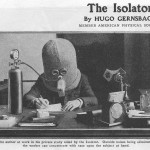In 1922, eccentric magazine publisher Hugo Gernsback decided that the world needed a 1,000-foot tall concrete monument to electricity. Gernsback imagined that this monument might last for thousands of years, and rather than some static behemoth stuck in time, the interior of his monument would be constantly changed to reflect  the technological advances of each new generation.
the technological advances of each new generation.
Gernsback’s article in the October 1922 issue of Science and Invention magazine explained why electricity was worthy of a monument. Interestingly, he saw it as a message to future generations that even if our civilization should be wiped out by war or natural disasters, we were still able to accomplish something great at one time.
In connection with our editorial of this month, we show on this page a monument dedicated to the age in which we are living. Electricity, more than anything else, has made our present civilization what it is, and if this civilization should be wiped out by war or some other cataclysm, nothing would remain to tell what Electricity did for the race during the past century.
Before the Egyptians built their first pyramid they probably foresaw that unless they built something of a tremendous size it would not stand the ravages of man and Nature. Hence the size and form were chosen in such a way as to make it last for practically all time.
Gernsback explained that this monument would look like a gigantic electrical generator, 1,000 feet tall. By comparison, the Statue of Liberty is just 305 feet tall, and the Empire State Building (which was almost a decade away from being built in 1930) isn’t that much taller than the proposed monument, at just 1,250 feet if you don’t count its spire.
When we therefore propose to build a gigantic monument to Electricity, we have the same objects in mind. On some plateau we could erect an electrical generator, molded in concrete, 1,000 feet high. Molded of the finest concrete, such a monument would last for a thousand years. It would probably not be affected by the weather and the climate, and it is doubted whether it could be easily destroyed by any savage race that might come after us.
In the inside passages, along the walls, could be inscribed, in diagrams and otherwise, electrical fundamentals, from the first static machine down to the latest radio developments. As new inventions come about, these can be inscibed from year to year.
If the entire electrical industry would think well of such a plan, a monument of this kind could be built without taxing any one concern a great amount. It would be a lasting tribute to our race, and to the progress that is exemplified by Electricity.
Gernsback doesn’t suggest where such a monument might be built, but judging by the illustration, it could very well be in Smalltown, U.S.A. The illustration is by Frank R. Paul, who would help define the 1920s and ’30s pulp sci-fi era’s aesthetic. Four years later, in 1926, Gernsback began publishing Amazing Stories, the first magazine ever devoted solely to science fiction. Amazing Stories featured countless covers and story illustrations by Frank R. Paul, whose most famous illustration for the magazine appeared in 1927 for a reprint of H. G. Wells’ War of the Worlds.In 1922, Hugo Gernsback envisioned a 1,000-foot tall concrete monument that “would be a lasting tribute to our race, and to the progress that is exemplified by Electricity”. Via: mithsonian.com.

The Isolator: l’elmo che stimola la concentrazione by Hugo Gernsback












